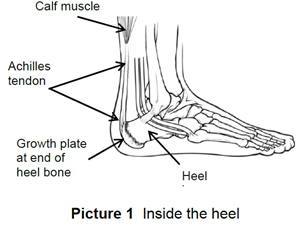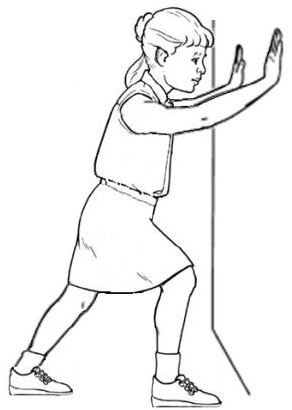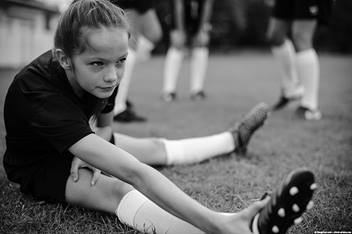Sever's Disease

Sever’s disease is a type of heel pain. It happens when the Achilles tendon is too tight and puts too much pressure on the growth plate in the heel (Picture 1). The growth plate is soft cartilage at the end of the heel bone.
Sever’s disease is common in children between 8 and 14 years of age that:

- Do running and jumping sports.
- Are going through a growth spurt. The bones grow faster than the tendons can stretch.
Sever’s disease may be painful, but it doesn’t cause long-term damage. It often goes away as the child gets older and when the growth plate closes.
Signs and Symptoms
- Heel pain that comes and goes
- Pain that gets worse with running and jumping activities
- Limping or walking on toes to avoid putting pressure on the heel
- Pain when the back of the heel is pressed or squeezed
- Pain that is worse when your child wakes up
Treatment
- Rest and change activities: Limit activities, like running and jumping, while having pain. Choose a different sport, like biking or swimming, until the heel pain gets better. Take rest breaks between activities.
- Ice: Ice the heel for 15 to 20 minutes when having pain or after activities. Do not place ice directly on the skin. Put a towel or other cloth between the ice and the skin.
- Pain medicine: Take over-the-counter (OTC) pain medicine, like ibuprofen (Motrin® or Advil®) or naproxen (Aleve®). These will also help reduce inflammation. Always give your child these medicines with food. Read the label to know the correct dose to give for your child’s age.
- Footwear: Wear shoes with padded soles and good support. Do not walk barefoot. In some cases, special inserts called heel cups may help.
- Stretches: Stretching will help loosen a tight Achilles tendon and take pressure off the growth plate.
- Stretch the calf muscles and Achilles tendon 3 times a day: in the morning when your child wakes up, after lunch or school, and before bed.
- Hold each stretch for 30 seconds. Repeat 10 times.
- Have your child continue doing these stretches even after their pain goes away. Stretching can prevent Sever’s disease from coming back.
| Stretches for the Calf Muscles and Achilles Tendon |
||
|
 |
|
|
 |
|
|
 |
|
Recovery
- Recovery from Sever’s disease is different for each patient. In most cases, it goes away on its own with rest, treatment, and time.
- The pain may come back or get worse if your child tries to play through the pain or if they do not follow the treatment plan.
- If your child has no more pain, they can slowly start doing more physical activities. They should still stretch before and after exercises to prevent Sever’s disease from coming back.
When to Call the Doctor
Call your child’s doctor or health care provider if they have:
- Severe pain that does not get better or go away with rest and pain medicine or the pain medicine is not working.
- Severe swelling or redness in the heel.
- An injury to the heel.
- A fever or temperature over 101° Fahrenheit (F) or 38.6° Celsius (C).
HH-I-342 • ©2016, revised 2022 • Nationwide Children's Hospital


